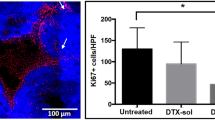Summary
Based on previous clinical findings following systemic administration, as well as appropriate laboratory evidence, the novel lipophilic anthracycline analogueN-Trifluoroacetyladriamycin-14-valerate (AD 32) has been identified as an agent of potential value in the intravesical therapy of superficial bladder carcinoma. Toward this end, using a rat model, the present study was designed to evaluate the potential for toxicity of a therapeutic dose of AD 32 given intravesically. With regard to systemic toxicity, following a single intravesical dose of AD 32 (20 mg/kg), the total systemic drug exposure (0–6 h), expressed as the area under the plasma concentration-time curve, was 14.2 μg min ml−1, or <1% of the corresponding value obtained when the identical dose was injected intravenously (2,392 μg min ml−1). In separate studies, a single intravenous dose of AD 32 (20 mg/kg) given to normal animals produced only a 20% reduction in white blood cell counts as compared with a 60% reduction following the administration of a therapeutic dose of Adriamycin (5 mg/kg); no effect was seen for either drug on red blood cell production. Taken together, these results imply that systemic drug exposure following the intravesical instillation of a therapeutic dose of AD 32 would result in negligible (∼0.2%) hematotoxic potential. Furthermore, intravesical instillation of AD 32 (20 mg/kg) at a concentration (10 mg/ml) greater than that projected for use in humans resulted in no evidence of contact toxicity to the rat bladder urothelium. Thus, based on experimental and clinical considerations of safety and efficacy, AD 32 appears to be an excellent candidate for the intravesical treatment of superficial bladder cancer.
Similar content being viewed by others
References
Blum RH, Garnick MB, Israel M, Canellos GP, Henderson IC, Frei E III (1981) Preclinical rationale and phase I clinical trial of the Adriamycin analog, AD 32. New drugs in cancer chemotherapy. In: Carter SK, Sakurai Y, Umezawa H (eds) Recent results in cancer chemotherapy, vol 76. Springer, New York Berlin Heidelberg, pp 7–15
Defuria MD, Bracken RB, Johnson DE, Soloway MS, Merrin CE, Morgan LR, Miller HC, Crooke ST (1980) Phase I–II study of mitomycin C topical therapy for low-grade, low-stage transitional cell carcinoma of the bladder: an interim report. Cancer Treat Rep 64: 225–230
Garnick MB, Griffin JD, Sack MJ, Blum RH, Israel M, Frei E III (1982) Phase II evaluation ofN-Trifluoroacetyladriamycin-14-valerate (AD 32). Anthracycline antibiotics in cancer therapy. In: Muggia FM, Young CW, Carter SK (eds) Developments in oncology, vol 10. Martinus Nijhoff, The Hague, pp 541–548
Garnick MB, Schade D, Israel M, Richie JF (1984) Intravesical doxorubicin for prophylaxis in the management of recurrent superficial bladder carcinoma. J Urol 131: 43–46
Gil P, Favre R, Durand A, Iliadis A, Cano JP, Carcassone Y (1983) Time dependency of Adriamycin and Adriamycinol kinetics. Cancer Chemother Pharmacol 10: 120–124
Goldin A, Venditti JM, MacDonald JS, Muggia FM, Henney JE, DeVita VT Jr (1981) Current results of the screening program at the Division of Cancer Treatment, National Cancer Institute. Eur J Cancer 17: 129–142
Herr HW, Laudone VP, Whitmore WF Jr (1987) An overview of intravesical therapy for superficial bladder tumors. J Urol 138: 1363–1368
Israel M, Modest EJ, Frei E III (1975)N-Trifluoroacetyladriamycin-14-valerate, an analog with greater experimental antitumor activity and less toxicity than Adriamycin. Cancer Res 35: 1365–1368
Israel M, Sweatman TW, Seshadri R, Koseki Y (1989) Comparative uptake and retention of Adriamycin andN-Benzyladriamycin-14-valerate in human CEM leukemic lymphocyte cell cultures. Cancer Chemother Pharmacol 25: 177–183
Krishan A, Israel M, Modest EJ, Frei E III (1976) Differences in cellular uptake and cytofluorescence of Adriamycin andN-Trifluoroacetyladriamycin-14-valerate. Cancer Res 36: 2114–2116
Lundbeck F, Pedersen D, Stroyer I, Uldall A (1981) Absorption of doxorubicin hydrochloride during bladder washings in the treatment of non-invasive bladder tumors. Urology 18: 161–163
Niell HB, Hunter RF, Herrod HG, Israel M (1987) Effects ofN-Trifluoroacetyladriamycin-14-valerate on human bladder tumor cell lines. Cancer Chemother Pharmacol 19: 47–52
Parker LM, Hirst M, Israel M (1978)N-Trifluoroacetyladriamycin-14-valerate: additional mouse antitumor and toxicity studies. Cancer Treat Rep 62: 119–127
Pavone-Macaluso M, Gebbia N, Biondo F, Bertitolini S, Caramia G, Rizzo FP (1976) Permeability of the bladder mucosa to thiotepa, Adriamycin and daunomycin in men and rabbits. Urol Res 4: 9–13
Renwick AG, Sweatman TW (1979) The absorption of saccharin from the rat urinary bladder. J Pharmacol 31: 650–652
Soloway MS (1988) Introduction and overview of intravesical therapy for superficial bladder cancer. Urology 31 [Suppl 3]: 5–16
Sweatman TW, Israel M (1989) Pharmacology ofN-Trifluoroacetyladriamycin-14-valerate (AD 32) administered to rats by intravesicular instillation. Proc Am Assoc Cancer Res 30: 600
Sweatman TW, Israel M (1990) Effect of surfactant formulation (NCI Diluent 12) on intravesical drug pharmacology. J Cancer Res Clin Oncol 116 [Suppl 1]: 538
Torti FM, Lum BL (1984) The biology and treatment of superficial bladder cancer. J Clin Oncol 2: 505–531
Vecchi A, Cairo M, Mantovani A, Sironi M, Spreafico F (1978) Comparative antineoplatic activity of Adriamycin andN-Trifluoroacetyladriamycin-14-valerate. Cancer Treat Rep 62: 111–117
Author information
Authors and Affiliations
Rights and permissions
About this article
Cite this article
Sweatman, T.W., Parker, R.F. & Israel, M. Pharmacologic rationale for intravesicalN-Trifluoroacetyladriamycin-14-valerate (AD 32): a preclinical study. Cancer Chemother. Pharmacol. 28, 1–6 (1991). https://doi.org/10.1007/BF00684948
Received:
Accepted:
Issue Date:
DOI: https://doi.org/10.1007/BF00684948




